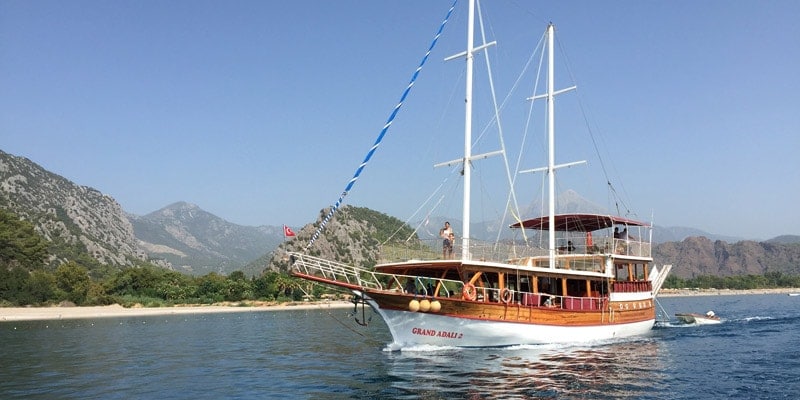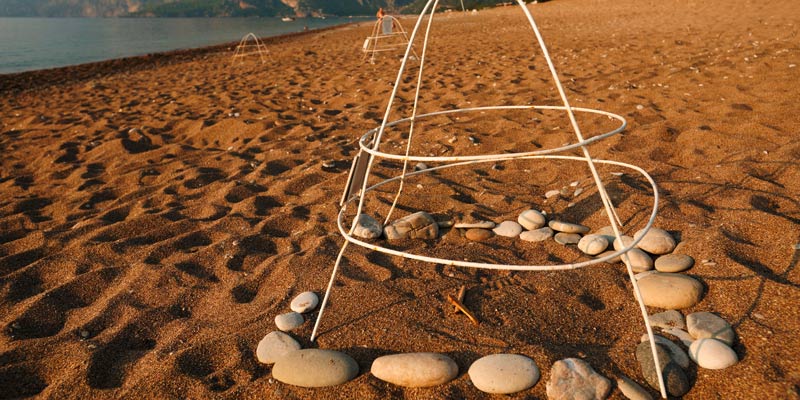At one of just 20 Turkish beaches to experience the phenomenon, visitors gather before the dawn to witness the magical first journey of baby turtles. Richard Hammond and family join in with turtle conservation in Turkey.
Hatch point
The water slaps and splutters against the side of the boat as four tiny legs kick and thrash, dancing a waterlogged jig. We’ve wrestled deflating armbands and rubber rings that refuse to slide over elbows but, finally, my two boys, Osian, three, and Owen, two, are out of the gulet and into the turquoise bay. As they bob and giggle in the water, the boys become more confident and start swimming, their doggy-paddle strokes at odds with the grandeur of an amphitheatre of pine-covered mountains that rises abruptly behind them on the shore. Everything stills for a moment, but the calm doesn’t last long. ‘Turtle!’ shouts a voice from the boat, and soon a shoal of snorkel tubes hurtles towards us as our fellow daytrippers try to get a glimpse of an adult loggerhead as it swims off serenely past the bow of our boat.

The gulet Grand Adali 2 runs turtle-spotting and snorkelling trips
Turtles are one of the big attractions of a holiday in Çıralı. A small resort 90 minutes’ drive southwest of Antalya, development here has, so far, been restricted, thanks to its location within the Olympos Beydaglari Coast National Park, as well as the conservation efforts of the villagers of Çıralı, NGOs and the Council of Protection of Historical and Natural Assets of the Turkish ministry of Culture and Tourism. Almost all the buildings are single storey and shrouded by gardens suffused with palm trees, jasmine and hibiscus. Between Çıralı’s best-known landmark – its 3.5km beach – and the mountains that rise just a few hundred metres behind it are pomegranate and orange groves, small market gardens and orchards. For kicks, there are boat trips to deserted beaches or ancient Greco-Roman ruins, river pools where you can swim within cycling distance, and toddler-friendly tractor-bus rides to nearby Chimaera, where sulphurous flames self-combust from the rocky hillside. If you’re there in August or September, there’s a chance you’ll see the hatching of baby sea turtles as they take their marathon first steps from nesting sites on the beach to the sea.
Cosy accommodation
We stumble on this information almost by chance, booking our trip not because of this extraordinary phenomenon, but because a friend recommended Çıralı as the place for the perfect toddler-friendly holiday. Which it certainly is. We booked to stay at family-run Hotel Azur, and found ourselves sharing it with a mix of Dutch and German guests, all of whom in the second week of September have under-fives in tow. Days quickly slip into a gentle routine, beginning with breakfasts of watermelon, figs, yoghurt, honey, toast, eggs and freshly squeezed pomegranate juice (OK, and Turkey’s answer to Coco Pops), before a play in the hotel pools, a lunch of homemade cumin-laced meatballs with buttery rice and juicy tomato salads (or finger-food-friendly grilled veg with garlicky yoghurt dips, aubergine salads and freshly baked bread), and an early afternoon nap. Afternoons are spent on the beach, which, with those karst-like mountains and warm, clear water could almost be Thai, before dinners of simple grilled fish and oven-baked halva at a lantern-lit beachside restaurant.

A Garden Villa among the orange trees at Hotel Azur
It’s a magical place, which feels like a million miles from mass tourism (there are certainly no wristbanded groups drinking their bodyweight in beer) – it’s just hikers, families and daytrippers from Antalya and Kemer. Everywhere we go, people welcome our children – from the little bakery, with its cushioned teahouses where we eat sticky vanilla and hazelnut cakes, to the beachside café with its ribbon-strewn trees, where we cool down with homemade lemonade.
In this mellow atmosphere, it’s easy for a holiday to drift by without even noticing the area’s turtle connection, but that would be a shame. Çıralı beach is an important nesting site for turtles, one of only 20 such turtle nesting beaches in Turkey. Numbers of this threatened species are dwindling, to the extent there are thought to be only 400 green and 2,000 loggerhead females breeding each year in the entire Mediterranean. The biggest threats to their existence include habitat loss, nest predation, incidental capture by fishermen and climate change.

Cirali beach is an important turtle nesting site
Helping hatchlings
The numbers of turtles nesting on Çıralı Beach has been closely monitored since 1994. When I was there in September, there had been over 100 turtle nests that season, thanks largely to the efforts of a local volunteering organisation – Ulupinar Conservation Co-op – an impressive grassroots conservation organisation that protects and monitors the nests. One of its small team of volunteers, Wilke from Germany, explained to me that the organisation is supported by a very low-key retail operation – basically, a stall by the beach that sells a few locally produced textiles, jewellery and honey, whose profits go towards maintaining the project.
It’s small projects like these that are making an important impact on turtle conservation in other areas of Turkey. Turtle conservation isn’t just limited to scientists, volunteers and NGOs; hoteliers whose properties are near to turtle-nesting sites are increasingly playing their part, too.

Volunteers build protective pods around nests
What is common to many of these projects is that they not only make a difference to turtle conservation, they also make evangelists of holidaymakers who have visited them. We got a glimpse of this on our final morning in Çıralı. Encouraged by tales from some of the other families staying in the hotel, all of whom had dutifully risen before dawn to go turtle-spotting, and all been rewarded with the sight of dozens of baby turtles, we hired a bike and set our alarm for 5am, even though we were told it was unlikely we’d see any turtles hatching, as only three nests remained. As Osian, our older boy, and I arrived at the beach in the dark, we found the small team of wardens from the Ulupinar Conservation Co-op, who beckoned us to follow them to the nests. They also told us to switch off our torches, so as not to distract the hatchlings, which use the light of the horizon to navigate to the sea, and can become disorientated by torchlight. At each nest site, the warden scratched below the surface to see if there were any hatchings emerging; unfortunately, none appeared. Although it was disappointing not to see the baby turtles, it didn’t really matter to Osian: he loved the experience of cycling out at dawn to the beach, and the mystery and thrill of scratching at the sand as the sun rose over the sea. As we pedalled back to the hotel, Osian kept grinning and telling me, ‘It’s nice being on holiday.’ When they’re as memorable as this, it’s hard to disagree.
The Marine Conservation Society and the UK sustainable tourism charity The Travel Foundation have produced an educational cartoon, Turtles in Trouble, which demonstrates how small changes to your behaviour while on holiday can make big differences to the lives of turtles.
Turtles in Turkey: the lowdown
Where to stay: A garden lodge at Hotel Azur costs from £81 per night
How to get there: Thomas Cook Airlines flies from Gatwick to Antalya from £990 return for a family of four from 24 August 2016.
Volunteering
Find out more about volunteering and participating in hatchling releases in North Cyprus.
Find out more about volunteering at Çıralı

